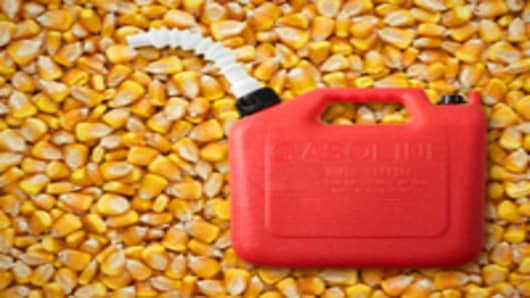Calls are growing to suspend the federal ethanol production mandate next year, as the worst drought in more than half a century has devastated the corn crop in the U.S. The question is whether a waiver of the Renewable Fuel Standard, or RFS, will actually bring down sky-high corn prices.
Georgia is among the states with major livestock production petitioning the Environmental Protection Agency for a waiver, arguing that scarce corn used for ethanol production is making feed prices unsustainably high for the state’s $20 billion poultry industry.
“Georgia has experienced severe economic harm during this crisis,” the state’s governor Nathan Deal wrote in a letter asking the EPA to issue a waiver.
“The state’s poultry producers are spending $1.4 million extra per day on corn due to the drought and the upward pressure on corn prices caused by the demand created by the RFS for ethanol,” Deal explained, citing research from the University of Georgia.
“Eight dollar corn is hard for all end users and that's no different for the ethanol industry,” counters Geoff Cooper, Vice Price of Research and Analysis at the Renewable Fuels Association.
In response to the spike in corn prices, Cooper said ethanol producers have seen margins fall and as a result have been forced to reduce their use of corn. Roughly two dozen of the nation’s 200 ethanol plants have gone idle this summer, effectively reducing production by 15 percent.
“We don't believe that a waiver of the RFS is necessary,” he maintains, because ethanol production credits could further reduce ethanol market demand for corn.
Credits, Waivers Could Lower Corn Price
“If a waiver were issued, then the price of corn would go down,” said Professor Wallace Tyner, agricultural economist at Purdue University. But he said the production credits could also bring the price lower.
For every gallon of ethanol produced, the industry earns credits, in the form of Renewable Identification Numbers, known as RINs. Ethanol production in 2011 exceeded federal targets, resulting in excess RINs, which could be used to meet the 13.2 billion gallon production mandate for 2012, or carried forward to use in 2013, when the RFS production target is set to rise to 13.8 billion gallons.
“They can reduce corn ethanol use by 2.6 billion gallons without any waiver,” Tyner explained.
In a recent report titled “Potential Impacts of a Waiver of Ethanol Blending Rules,” Tyner and his colleagues calculated that under extreme drought conditions with no reduction in the 13.8 billion gallon RFS in 2013, corn prices could rise to roughly $8.57 a bushel.
If the industry used carry-over RIN credits for up to 2.5 billion gallons, the lowered level of production would result in cutting the bushel price by about $0.67.
A partial waiver, cutting production by about 25 percent, would bring corn prices down by roughly a dollar to about $7.50 per bushel. A more substantial waiver, reducing production targets by around 40 percent, could cut the price down to about $6.50 a bushel.
But, Tyner said it is not clear how much flexibility refiners have to retool for using less ethanol, which makes up about 10 percent of gasoline blends.
“The feedback we get from the industry is really mixed,” he said. “It’s absolutely critical the EPA get a good handle on that before they make any decision.”
Costlier Blend of Gasoline
Analysts say that while congress gave the EPA the authority to waive the RFS mandate for up to a year, the agency does not have the power to enforce a waiver.
“Refineries, when they're making their base stock to blend with ethanol, are unlikely to make any changes at the local level,” said oil industry consultant Andy Lipow, of Lipow Oil Associates.
One issue that complicates retooling, is that using less ethanol would involve changing the octane levels of the gasoline refiners produce. Many now refine gas with an octane rating of 84, using ethanol to boost the level to 87 for regular gasoline.
The bigger issue is price. Reducing the 10-percent ethanol blend, would raise the cost of finished gasoline. A pullback in corn and ethanol prices makes blending more attractive.
“If you were to look at the gasoline futures price it's around $3.00 a gallon, but ethanol prices throughout the Midwest are only $2.60 a gallon which makes economic sense to continue blending,” said Lipow.
“Do you want cheap corn or do you want cheap gasoline?” asked Commodities trader Larry Shover, chief investment officer of SFG Alternatives. “That's the conundrum we're in.”
Shover said a complete waiver of the 2013 RFS would hit ethanol producers hard, and wipe out the value of tightly traded RIN credits. Right now, he said the RIN market is not pricing in a major waiver.
November Deadline
With several states formally petitioning for an RFS waiver, the EPA has announced a 30-day comment period on the issue, and is expected to issue a decision by November 13.
When commodity prices soared in 2008, the agency denied a petition for an RFS waiver by Governor Rick Perry of Texas, on the grounds that his request did not prove sufficient economic harm.
This time, with the worst drought since the Great Depression, states may have a strong case.
“The economic damage done by the drought is done,” said Purdue Professor Tyner. “The EPA has to make the hard judgment of how they are going to share or distribute the pain caused by that drought.”
-Written by CNBC's Bertha Coombs. Follow her on Twitter @coombccnbc. Questions? Comments? Email us at marketinsider@cnbc.com



